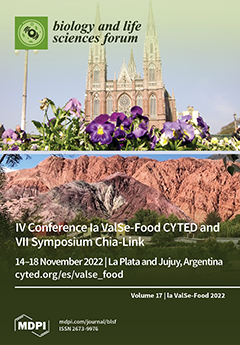An organic-free method was applied to produce corn starch nanoparticles, which were designed to stabilize Pickering emulsions containing chia oil, the richest vegetable source of omega-3 fatty acids. The liquid stream resulting from a laboratory-scale mill assisted by zirconia beads was filtered, centrifuged
[...] Read more.
An organic-free method was applied to produce corn starch nanoparticles, which were designed to stabilize Pickering emulsions containing chia oil, the richest vegetable source of omega-3 fatty acids. The liquid stream resulting from a laboratory-scale mill assisted by zirconia beads was filtered, centrifuged and homogenized to prepare the continuous phase of the emulsions. Experiments were performed as follows: 24 h (milling time), 0.1–0.2 mm (beads’ diameter), 1600 rpm (impeller speed), 25% (volume occupied by the grinding media), 1–7%
w/
v (starch concentration) and 0–1%
w/
v of sodium dodecyl sulfate (SDS). Particle sizes in the obtained nanosuspensions were reduced from 376–432 nm to 160–200 nm after centrifugation and homogenization. The product formulated with 0.01%
w/
v of SDS showed the most stable particle size during storage. Hence, this latter formulation was selected to prepare Pickering emulsions. Oil droplets showed surface mean diameters and polydispersity indexes of 283.33 ± 1.53 nm and 1.36 ± 0.03, respectively, with no significant variations during storage for around two weeks. Finally, nanosuspensions containing 7%
w/
v of starch, and the above three concentrations of SDS, were filtered, centrifuged, homogenized and spray-dried to obtain redispersible powders able to stabilize Pickering emulsions. The most stable particle size after redispersion (385.83 ± 5.85 nm) was obtained with the highest concentration of SDS. Moreover, SEM images revealed the presence of round-shaped particles with sizes below 1 μm. These results highlight that wet-stirred media milling can be applied as a green-method to produce new food-grade starch nanoparticles, which are able to deliver bioactive compounds from chia oil.
Full article



